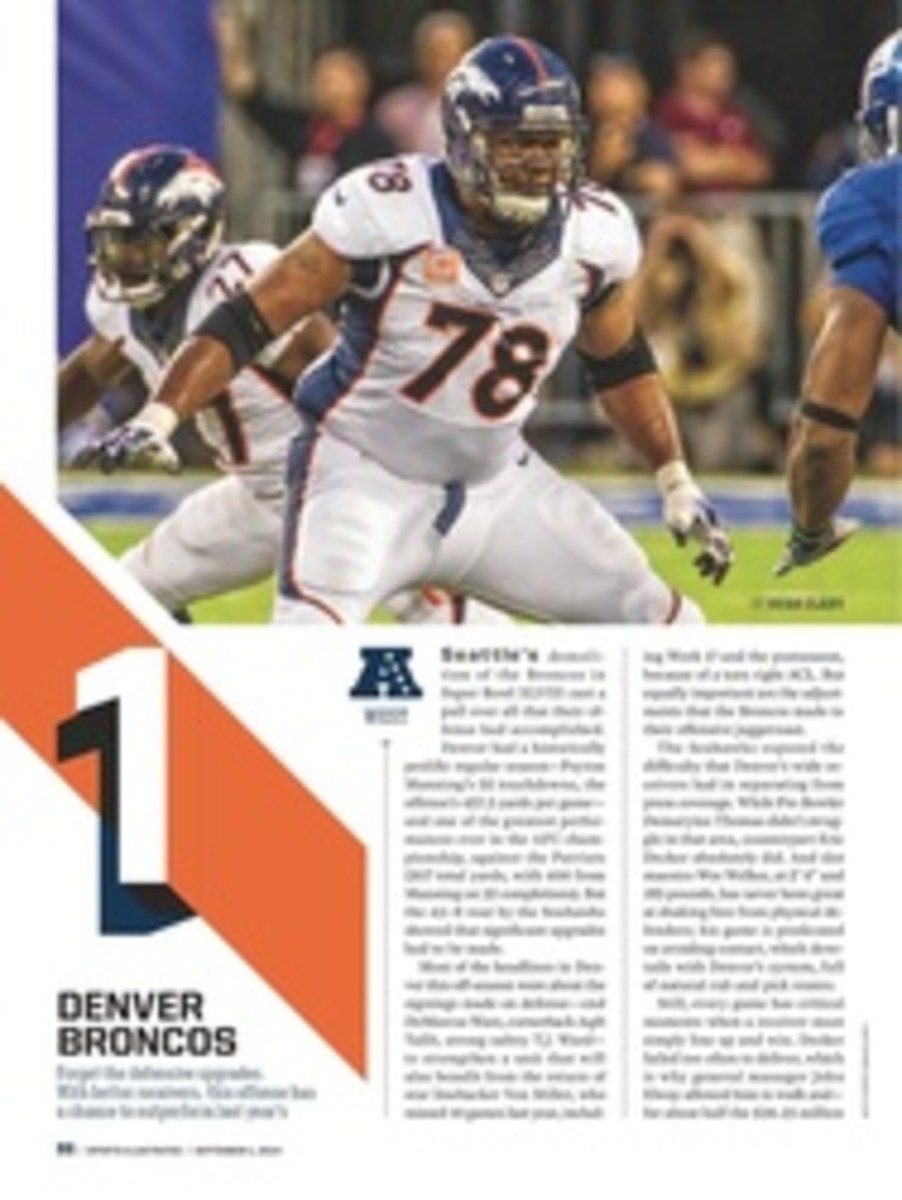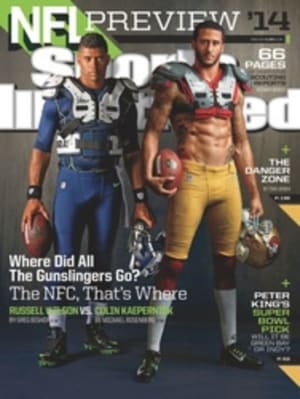
4 JACKSONVILLE JAGUARS
Distinctively mustached owner Shahid Khan and young second-year GM Dave Caldwell seem intent on turning their club into the Seahawks of the Southeast. They began by hiring Seattle defensive coordinator Gus Bradley as coach a year ago. The 48-year-old Bradley, who shares Pete Carroll's effervescence and optimism, also has his former boss's taste for physical yet zone-oriented defense.
The scheme, being so straightforward, is not difficult to teach; the challenge is finding the players to execute it. Bradley doesn't have anywhere near the talent now that he had with the Seahawks, though Caldwell did sign a pair of free-agent defensive ends from the Super Bowl champs. Red Bryant, one of the best two-gap run defenders in the league, will start on the weak side. At 6'3" and 254 pounds, the sinewy Chris Clemons will push for double-digit sacks while subbing for Bryant on passing downs.
Both are substantial upgrades and will help address the greatest difference between the two defenses: their four-man pass rushes. The Seahawks have an effective one, the Jags do not. Even with Clemons they are short an edge-bender on the other side. Andre Branch, a 2012 second-round pick, was supposed to be that guy, but aside from the occasional splash, he hasn't shown much. Strongside defensive end Tyson Alualu can make noise as an interior rusher in nickel, but he's not the sort of force that keeps offensive line coaches up at night.
Another major difference is between the two secondaries. Seattle's defense relies on the range of free safety Earl Thomas and the physicality of strong safety Kam Chancellor. Another former Seahawk, Winston Guy, is playing the role of Thomas. He doesn't have the All-Pro's range, but he's familiar with the scheme. In Chancellor's spot is Johnathan Cyprien, the 33rd pick in 2013, from Florida International, who like Evans is still learning to read the field. Cyprien defended tight ends man-to-man at times as a rookie, and his assertiveness, if harnessed, can make him a force in the box.
Fortunately for the young safeties, field awareness can be taught and learned. What can't be taught is size and length—key traits for a Seahawks-style cornerback. At 5'11" and 201 pounds, 2013 third-round pick Dwayne Gratz—who was the third rookie in Jacksonville's starting back four last year—is lacking in these departments. However, Gratz has a knack for jamming receivers in the first five yards and pressing after that. He might be better suited long-term for the slot, but this defense was noticeably stingier when he started outside opposite veteran Alan Ball last season. Ball is back, as is versatile eighth-year corner Will Blackmon.
In between the front line and secondary, the Jags do have Seahawks-type speed in linebackers Paul Posluszny and Geno Hayes, two refined downhill attackers. They also have run defenders up front who can keep these backers clean. Besides Bryant at defensive end, sixth-year defensive tackle Sen'Derrick Marks (the three technique) offers wonderful quickness and athletic twitch, while cohort Roy Miller (the nose shade) flashes good initial movement for a rotund 6'2" 310-pounder.
The Seahawks last year had a league-best 39 takeaways; Jacksonville a ho-hum 21. In Year 2 under Bradley, the Jaguars will have to force more turnovers, if not through faster play then by taking more chances with blitzes and coverage changeups—tactics Bradley normally reserved for third-and-short.
Jacksonville will need the defense to deliver big plays because the offense is unlikely to create many. While the additions of quarterback Blake Bortles, the No. 3 pick out of Central Florida, and second-round rookie receivers Marqise Lee and Allen Robinson should help a passing attack that was impotent last year, the real payout on those choices may not come until 2015 (or later), as Bradley and his staff claim to be leery of rushing youngsters into action.
That's their stance heading into the season, but coaches have a way of changing their minds in September. When the games start counting, Bradley could at some point find himself applying the Seattle blueprint to his offense as well and going with an inexperienced quarterback—No 3 pick Blake Bortles over Chad Henne. That will work only if the defense is stingy.
2014 SCHEDULE
2013 Record: 4--12
WEEK 1
PHI [AWAY]
WAS [AWAY]
IND [HOME]
SD [AWAY]
PIT [HOME]
TEN [AWAY]
CLE [HOME]
MIA [HOME]
CIN [AWAY]
DAL LONDON [HOME]
BYE
IND [AWAY]
NYG [HOME]
HOU [HOME]
BAL [AWAY]
TEN THUR [HOME]
HOU [AWAY]
WEEK 17
THE BIG FIX
The receivers
Spending second-round picks on Marqise Lee (USC) and Allen Robinson (Penn State) was a welcome move in Jacksonville, if for no other reason than the Jags might finally have receivers who can get free from man coverage. Last year, with Justin Blackmon suspended, Cecil Shorts was the top target. While Shorts can make the occasional big play, on most teams he'd be the first receiver off the bench. The Jaguars also have undrafted third-year pro Mike Brown, who is cerebral in the slot and has a good sense for throttling down in vacant zone areas. He can be effective on crossing patterns—which coordinator Jedd Fisch's up-tempo system should start featuring regularly, given that the speedy Lee and the brawny Robinson run well after the catch. Complementing all these wideouts is Marcedes Lewis, a 6'6", 272-pound tight end who can high-point the ball, though he must develop better hands. It's a group in need of help, which may have just arrived.
THE CASE FOR
Guard Zane Beadles
GM Dave Caldwell possibly have overpaid just a hair in giving the former Broncos left guard a five-year, $30 million contract ($12.5 million guaranteed), but anyone who watched Jacksonville's interior linemen a year ago can't blame him. Their lack of power derailed the Jaguars' running game, and pass protection was rife with individual breakdowns. Beadles will be a dramatic upgrade simply by not stinking. At right guard the hope is that third-round rookie Brandon Linder, who is expected to start on the other side of questionable center Mike Brewster, can also reach that low bar. The 6'4", 305-pound Beadles moves well in his run blocking—a talent shared on this O-line only by second-year left tackle Luke Joeckel, the No. 2 pick of 2013, who fractured his right ankle last October. Most of the rushing concepts will be built around these left-side linemen, either through pull blocks, reach-and-seal zone blocks or just straight-ahead plowing. New starting running back Toby Gerhart possesses only limited lateral quickness and agility, so for the Jags' ground game to go anywhere, it'll need superior blocking. At least Beadles gives them a fighting chance.
PHOTO
DAVID E. KLUTHO/SPORTS ILLUSTRATED
DE RED BRYANT
PHOTO
DAVID E. KLUTHO/SPORTS ILLUSTRATED
NINTEEN PHOTOS

